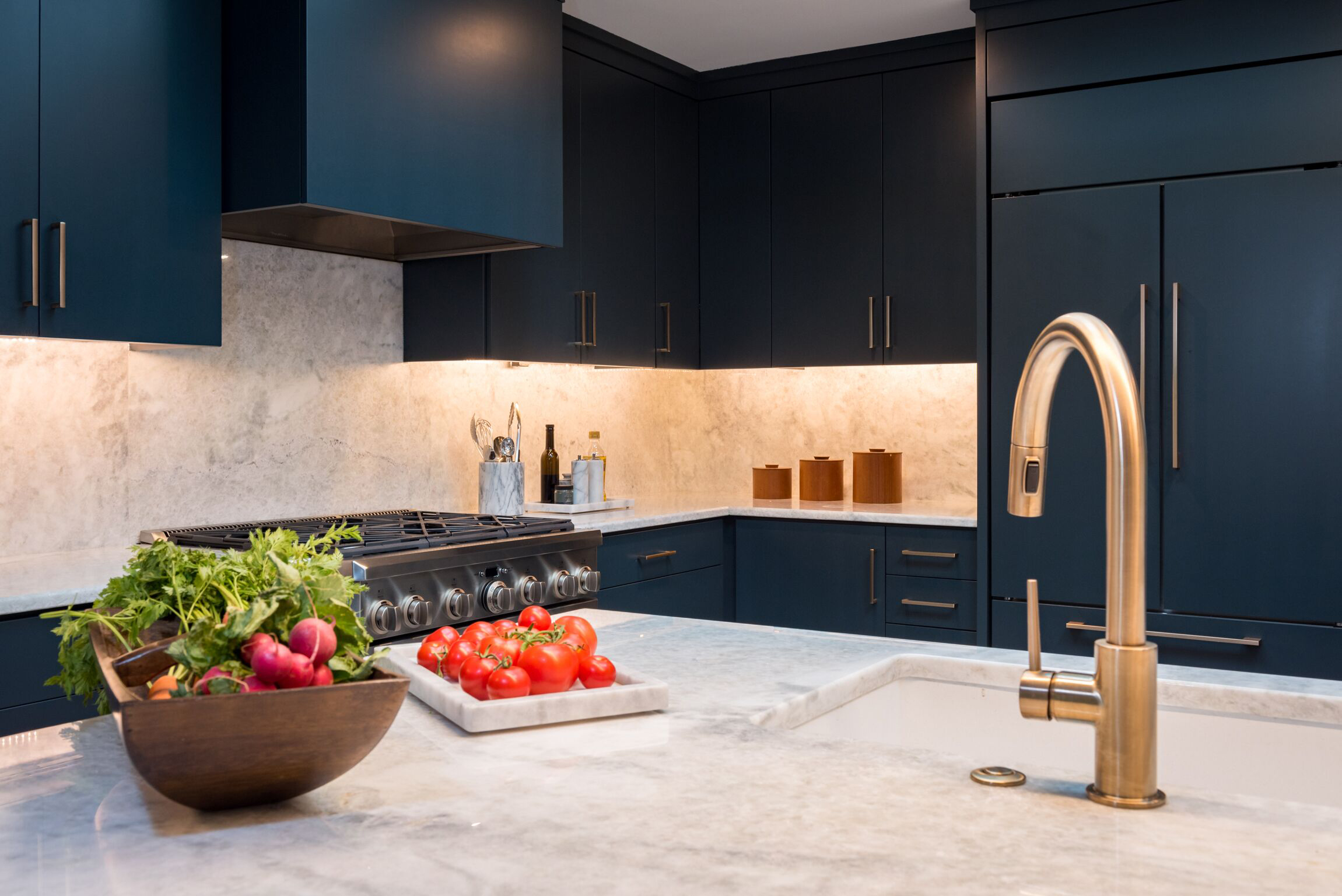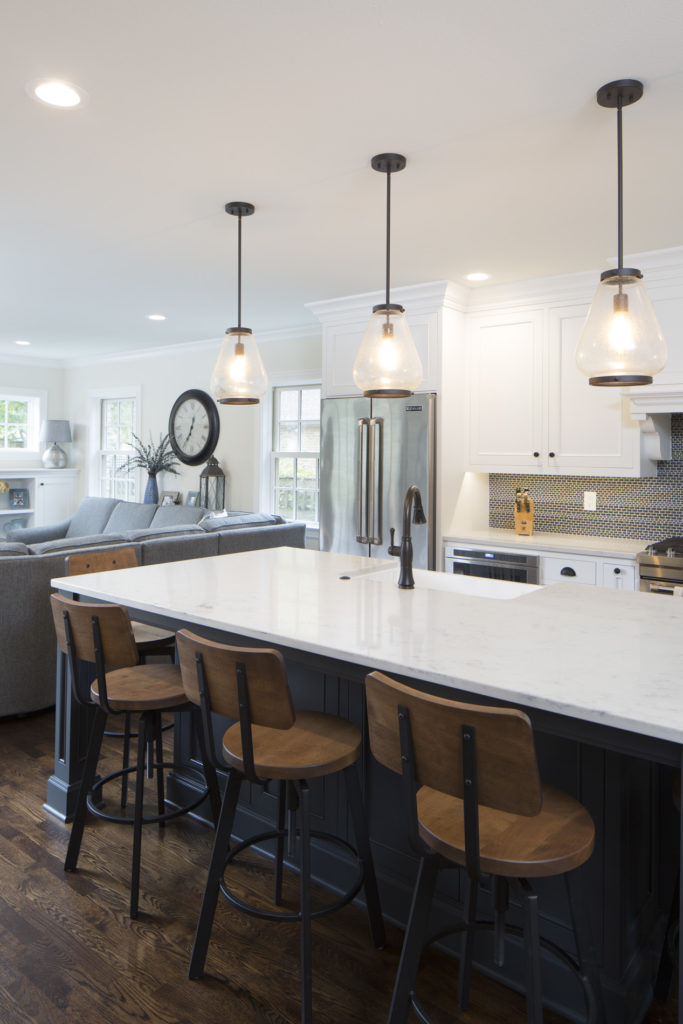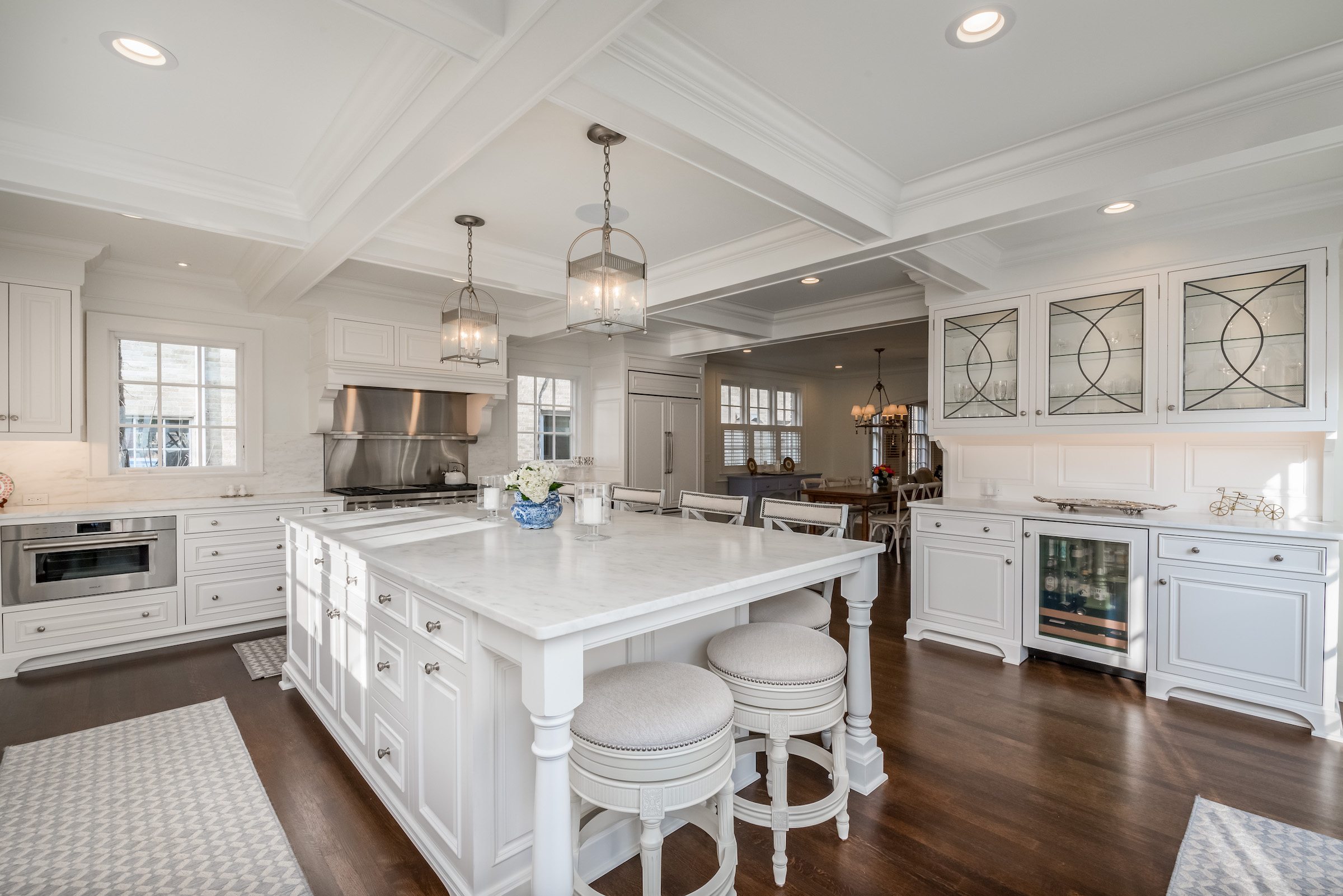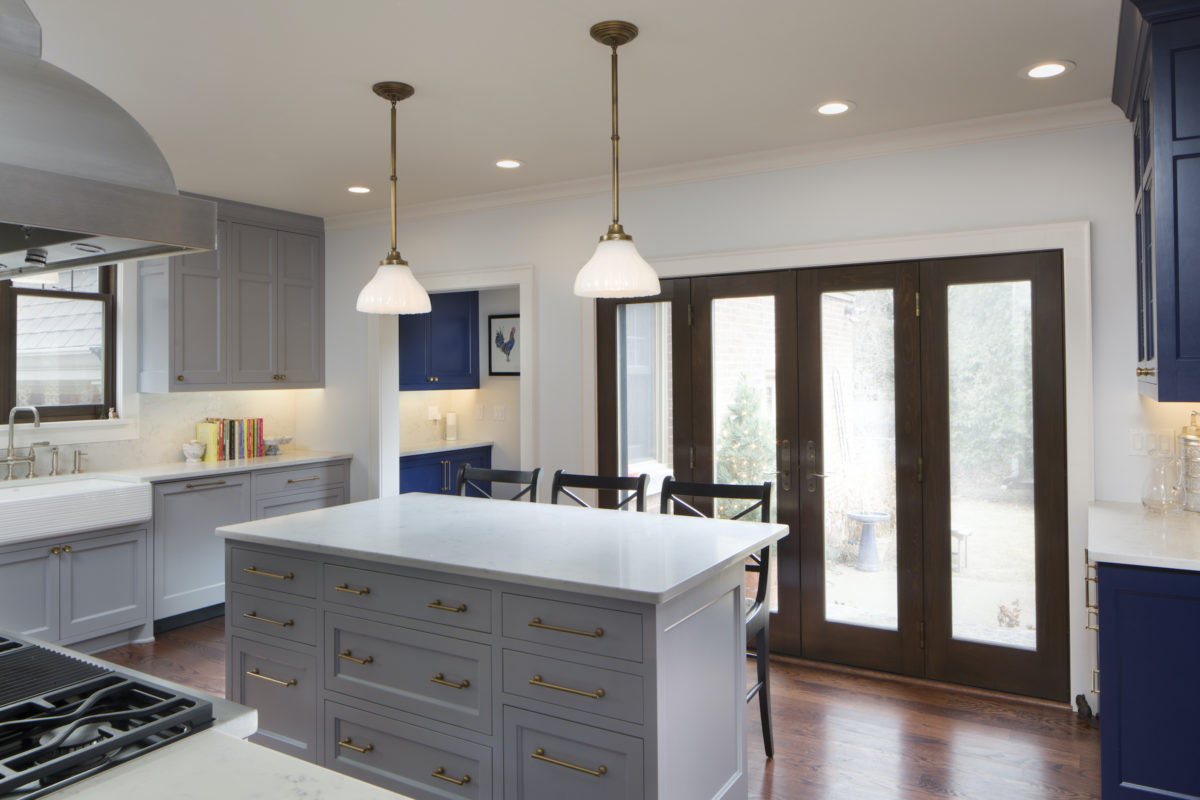Selecting a countertop for your kitchen remodel not only impacts the aesthetic of your space, but also affects your budget and the way you cook. Called benchtops in Europe, countertops occupy one of the largest surface areas of any material in your kitchen. Most of the different types of countertops we offer our clients when doing a kitchen remodel can be measured on the Mohs scale. This ranks the hardness of a mineral from one to ten, with talc being the softest and diamonds being the hardest. Understanding how your countertops will wear can help you decide which material is best suited for your kitchen remodeling project.
Many of the countertops used in a kitchen remodel are a stone of some type. There are several different edge profiles that can be routed into the stone to make it look more traditional, while others create a more modern aesthetic. Most commonly, our clients request an eased edge. We can also seamlessly laminate another piece of stone to the bottom of the slab to make the countertops appear thicker.
Granite
Derived from the Latin word ‘granum’, granite is an igneous rock formed by the cooling of magma approximately 300 million years ago. It is a composite of many minerals including quartz, and is harvested from stone beneath the earth’s surface. It has been in use as a building material since the time of the Egyptians. Granite also forms famous landmarks, such as Mount Rushmore. It naturally occurs all over the world, but is commonly quarried for countertops in the USA, China, and Brazil.

When remodeling your kitchen, granite prices range from some of the least expensive solid surface options, to some of the most expensive. Granite can have all of the same edge finishing profiles as other stones and the surface is most popularly polished. Granite can also be installed honed or leathered.
Mohs Rating: 6-8
| Pros | Cons |
|---|---|
| Heat resistant | Must be done professionally |
| Can be one of the least expensive of the stones | Imperfections can be unappealing and cause waste |
| Thousands of color choices | Natural stone can have naturally occurring weak spots, causing cracks |
| Seen by many as a luxury product | Cannot cut directly on the stone |
| Low maintenance | Requires sealing |
Laminate
While working at Westinghouse, Herbert Faber and Daniel O’Conor invented Formica® laminate. They filed for a patent on their laminated plastic with phenolic resins in February of 1913. After leaving Westinghouse, the company manufactured their product for uses in consumer electronics. By the 1920s, patterns to mimicked stone and wood were developed. The use of Formica® for countertops became popular after WW2.
Laminate countertops are produced by laminating layers of paper together using resins, heat and pressure to form a single semi-rigid plastic sheet. These sheets are then glued onto a medium density fiberboard (MDF) core in the shape of the countertop using contact adhesive.
At LaBonte Construction, we use Formica® countertops most often in mid-century modern kitchen remodels. Additionally, we us Formica® in basement laundry rooms when a client wants to save money.
Mohs Rating: N/A
| Pros | Cons |
|---|---|
| Least expensive option | Edges can delaminate |
| DIY or carpenter install | Not easily repaired |
| Many color options | Seams cannot be hidden |
| Stain resistant and easy to maintain | Seen as a budget option during resale |
| Integrated sinks available from some fabricators |
Quartz
Unseating granite as the most popular countertop installed during kitchen remodels is quartz. Quartz is a manmade material that gives the appearance of natural stone, without the maintenance. These countertops are primarily made of ground quartz mixed with a polyester resin and pigments. Some of the more exotic looking quartz countertops include glass and metallic flakes. These can add visual interest and movement to the slabs.

Unlike other stone countertops, quartz does not need to be sealed and comes in larger, more uniform slabs. When quartz first came to market, many complained about the lack of colors and the inability to hone the surface. The latest generations of quartz have solved this issue. They not only offer the ability to have a honed finish in as many colors as natural stone, but also much longer pieces. This has helped accommodate today’s larger kitchen islands.
Mohs Rating: 7-8
| Pros | Cons |
|---|---|
| No sealing required | Expensive |
| Uniform in size, veining and color | Some brands do not offer a honed finish |
| Resists stains, etching and heat | Heavy when compared to some of the other engineered products |
| Most realistic of the engineered products |
Concrete
A perennial choice of the DIY crowd and interior designers looking for a brutalist design in their kitchen remodel, concrete is often an overlooked option. Concrete is very versatile when used as a countertop. By etching, stamping, acid-staining, adding other materials such as glass, changing the size of the aggregate or by the way the final product is sanded, one would not recognize it as the boring gray slab in the backyard.
Concrete countertops can be poured in place, or fabricated off-site and delivered. By pouring the tops in place, a seamless installation can be achieved. Also appealing to some clients, is the ability to mold in the sink in the same material, although this can be a weak point. You should talk to a qualified kitchen remodeling contractor about the need to build a support system for this type of installation.
Mohs Rating: 5-7
| Pros | Cons |
|---|---|
| Unique look | Can crack |
| DIY friendly | As, or more expensive as other solid surface options if professionally fabricated |
| Sink can be integrated | Can be messy if cast in place |
| Many textures and colors can be achieved | Requires regular sealing |
| Scratch and heat resistant | Can seem cold in some spaces |
Tile
This is one of the least expensive and most DIY-friendly options. Tile countertops took over the kitchen remodeling world in the 1980s and into the 1990s. Tile became popular as it was a way to express your creativity. Size, shape, color, price, and layout are the only limiting factors when picking a tile countertop. While not as common anymore, there are still instances where tile countertops are specified in a kitchen remodel.
Mohs Rating: N/A
| Pros | Cons |
|---|---|
| Affordable | Uneven surface can cause spills |
| As many styles as there are colors | Grout joints can harbor bacteria and stain |
| DIY friendly | Is not as prestigious as solid surface counterparts, even if it is the same material |
| Materials are widely available | Is more delicate than many solid surface options |
Soapstone
First discovered by Native Americans, soapstone is a metamorphic rock made of talc and other minerals. Mined in the Appalachian Mountains, soapstone comes in a variety of shades and colors. Most commonly it comes in dark gray, green, or black with veins of whites of grays. In kitchen remodeling, soapstone is almost always sold with a honed surface.
In addition to being used in kitchen remodeling, soapstone is commonly used to make sinks or to line fireplaces in old homes. Today, soapstone is a great choice for bars where wine is served and lemons are cut because of its natural acid resistance.
Soapstone takes on a patina over time and will require periodic applications of mineral oil. Scratches can be removed by sanding the countertop.
Mohs Rating: 2.5-5
| Pros | Cons |
|---|---|
| Stain resistant | Must be oiled to keep appearance |
| Superficial scratches can be buffed out | Surface is somewhat delicate and scratches easily compared to harder stone |
| Offers historically accurate look | Color can change over time, impacting original design |
| Beautiful, dark color |
Marble
Marble is metamorphic rock formed millions of years ago by limestone being put under pressure. A popular choice amongst the ancient Greeks and Romans, it was used as a building material because of it’s aesthetics. Although marble is a soft stone, some of these Greek and Roman marble structures still stand over 2,000 years later. Other historical uses of marble include the Taj Mahal in India and the cladding of some Egyptian Pyramids.

Marble is a soft stone, but does not retain heat. It was popular a building material because marble can create a cooling effect in warm climates. Seen as one of the most exotic and expensive kitchen countertop options, it is popular in high-end bathroom and kitchen remodeling.
Mohs Rating: 3-5
| Pros | Cons |
|---|---|
| Seen as an ultra-premium material | Expensive |
| Can be finished in multiple different finishes | Softer than some other solid surface options |
| Natural veining creates one-of-a-kind look | Can be scratched or stained |
| Requires sealing |
Corian®
Donald Slocum’s invention, a combination of acrylic polymer and alumina trihydrate, Corian® is a name-brand solid surface material that comes in over 100 colors. It is manufactured in Buffalo, NY by the industrial giant DuPont. Corian® comes in three thicknesses: ¼”, ½”, and ¾”, and the color is uniform throughout the material. Obviously, the thicker the material, the more durable and ridged the countertop is. The material was reformulated in 2013 in an effort to revive the once ubiquitous brand. This reformulation created deeper, darker colors in addition to adding more resistance to abrasions.
Mohs Rating: 2
| Pros | Cons |
|---|---|
| Stain resistant | Can be as expensive as natural stone options |
| Damage can be buffed out | Seen by some as dated, or for commercial use |
| Uniform | |
| Seams are nearly invisible | |
| Many color options | |
| Sink can be integrated |
Butcher Block
No longer relegated to the farm, butcher block countertops have become increasingly popular in kitchen remodeling. Butcher block countertops can be made from any species of wood and are composed of strips of wood glued together. Available grain orientations include: edge grain (most common), face grain and end grain. While most other countertops can dull knives, butcher block tops are great for cutting directly on. This is as long as you do not mind the character caused by knives.
Butcher block kitchen countertops should not have finish on them if they are used for food prep. These coatings can encourage bacteria growth trapped in the scratches and imperfections. Using a food grade butcher block conditioner will be required at least once every six months. Also, take special considerations around sinks. Untreated wood does not do well in constantly wet environments like a sink area.
Mohs Rating: N/A
| Pros | Cons |
|---|---|
| Inexpensive for some woods | Some woods can be expensive |
| Can be sanded to restore appearance | Seams are hard to hide |
| Creates a warm look | Scratches and stains easily |
| Lasts indefinitely if cared for correctly | Not always food safe |
| Easy to find with most big box stores now carrying them | Must be oiled to avoid cracking and discoloration |
Metal
While typically found in commercial kitchens, metal countertops have become more popular in American kitchen remodels. Most commonly the metals used are stainless steel, pewter, copper or zinc. While most people think of these metals for range hoods or appliances, metals can make great countertops. Except for stainless steel, all of these metals will oxidize, forming a beautiful patina.
Stainless steel is the most common of the metal countertops. Usually used by designers and homeowners to create a modern look, stainless steel offers unparalleled durability. Homeowners should understand that there will be superficial scratches in the surface from use, but many love the worry-free nature of this hearty material. Cleaning with soap and water is the only maintenance this kitchen countertop should need.
Zinc is often seen as the cladding on oyster bars, but has made its way into residential kitchens. Zinc develops a blueish-grey patina. Since the metal is soft, different edge profiles can be bent into the metal.
Copper has long been used for plumbing fixtures, but a copper countertop can be functional and beautiful. After installation, the bright rose gold color usually turns a dark brown with hints of green. Though uncommon, some wish to maintain the surface in its original color by polishing with a product like Bar Keepers Friend to remove the patina. As a bonus, copper naturally inhibits germs with E. coli, with the germs only surviving for about four hours on the surface.
Pewter is an alloy of tin and is popular in French restaurants and those looking to bring a French flair to their kitchen remodel. With a grey patina, pewter is a timeless and elegant metal option that is soft enough to press decorative edge details into.
Mohs Rating: N/A
| Pros | Cons |
|---|---|
| Strong | Hard to find a fabricator for some residential projects |
| Easy to clean | Scratches easily |
| Food safe | Noisy |
Picking the right countertop for your kitchen remodel can be intimidating. To help you decide, we suggest weighing the pros and cons of each countertop type, looking at inspiration pictures from Houzz, and by contacting a qualified kitchen remodeling company like LaBonte Construction.

